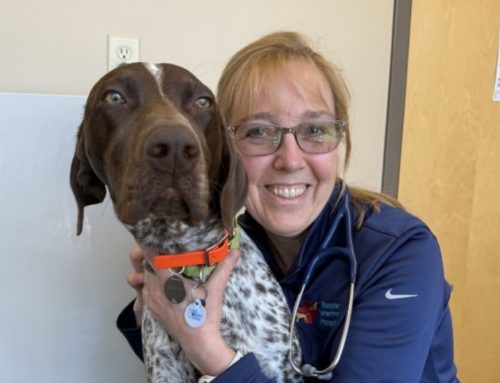Kids are headed back to school and you are off to work. But, what will your pet do? Check out Bassler Veterinary Hospital’s secrets for a successful, smooth transition for the whole family, but especially your pet.
#1: Ease your pet into a new school year schedule
Begin making gradual changes to your family’s daily schedule several weeks before school actually starts. This will give your pet time to adapt and not be frightened when the family is suddenly gone for 8 to 10 hours a day. Start by leaving for an hour, and slowly increase the time, depending on your pet’s response.
If your pet’s meal times will be earlier or later than usual on the new schedule, make this part of the gradual transition. A pet’s gastrointestinal system primes itself according to regular feeding times, and a pet who is forced to wait too long with an empty stomach may become sick and vomit.
#2: Rehearse calm goodbyes and greetings with your pet
This is actually a matter of training the family, rather than the pet. Dogs can display some theatrical behavior to greet their family returning from work and school, and family members who respond in kind encourage this behavior.
Your vibe should be the same for your departures. Leaving a beloved pet is difficult, but indulging them with an extended, sorrowful farewell, and multiple hugs or treats, will not only increase their anxiety about your leave-taking, but add extra calories that no stay-at-home pet can afford.
Teach your dog that family comings and goings are not a big deal by not making a huge production. Family members should calmly say good-bye and leave, or quietly greet your pet. Ignoring the dog completely for the first few minutes after returning home will likely stop their behavior.
#3: Schedule regular exercise for your pet
Pets become used to a certain activity level during the summer, especially when children are at home. When kids return to school and parents to work, pets are suddenly faced with long spans of inactivity. Although dogs sleep 12 to 14 hours a day on average, and cats an impressive 15 to 20 hours, they still require regular physical exercise and social interaction to maintain a healthy mind and body. Ensure you include quality time and physical exercise when you fill your calendar with all the kids’ morning and evening extra-curricular activities. If pets are left alone with too much excess energy, you may return home to find they have “redecorated” your living space.
Too busy? Dog-walking services are available in most urban and suburban areas, and are a great way for your dog to maintain an active lifestyle. Day care also can help social dogs to get some exercise while enjoying their friends. Always do your research and schedule a trial run or playdate to see if your dog approves, as not all are interested in organized socialization.
#4: A cubicle for you, a crate for your pet
Decide in advance where your pet will spend the school day. If you can trust your pet during your absence, you may not need to modify their accommodations, but you may want to restrict their environment if they will likely cause trouble.
- Close off the cat — Cats can be kept in a closed-off room or area to minimize mischief, but ensure they have access to their litter box, food, and water.
- And the dog — Dogs can be likewise restricted, but consider whether a closed door will agitate or panic your dog. A baby gate may be more appropriate.
- Pets and windows — If your dog is easily upset by the world beyond the windows—full of delivery men, stray cats, and strangers—they may become frustrated, and may be more comfortable if they are kept away from windows, if possible. Other pets, especially cats, enjoy window-watching.
- Pets and crates — A crate provides excellent confinement, as long as your dog enjoys their crate. If they don’t, they may panic and harm themselves. Most pets can be trained to be happy and feel secure in their crate.
Try out several different arrangements while you prepare for the schedule change, so everyone has a smooth and successful “first day.”
#5: Teach your pets something new, too
Give your dog a new experience by signing them up for a fun dog training class, which is a great way to bond, and to help them feel more satisfied during the week.
For home-schooled pets, an array of mental enrichment toys are available to engage their critical thinking skills and challenge their senses. Stimulating a pet’s mind will also help tire them out, so if you have had a busy day and your pet is bouncing off the walls, find them a game to play.
#7: Do you anticipate separation anxiety? Let’s talk

If you worry that your pet may experience separation anxiety, or have a hard time coping with the new family schedule, contact us. Many helpful options, such as pheromone products for dogs and cats, supplements, and anti-anxiety medications, are available to help ease your pet’s worries and prevent anxious behaviors, such as destructive behavior and house soiling, from becoming habits.
We hope that you have done your homework for your home-alone pet, and you have no need to fear the coming school year. If you do have questions about separation anxiety in pets, contact Bassler Veterinary Hospital.








Leave A Comment